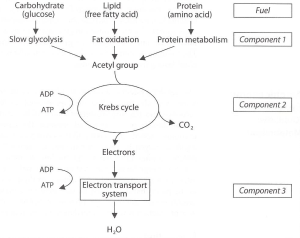Source of Fuel – The aerobic system can use CHO, fats, and protein as its source of fuel, though protein is used sparingly. The aerobic system uses aerobic glycolysis, the Krebs cycle and the electron transport chain in its production of ATP. It is the presence of oxygen, which allows this energy system to use these various fuel sources.

Sourced from www.zentofitness.com
Efficiency of ATP Production – The aerobic system is very efficient in producing ATP. It produces 38 ATP molecules per glucose, but the
rate of production is medium and cannot cope with the higher intensity levels.
Duration that the system can operate – This energy system can produce ATP continuously for well over an hour. In fact, it may not have a limit as long as fuel sources can be found (you will die if this energy system cannot be used). However, your muscle glycogen will deplete after about an hour of exercise, which will result in an increased need for oxygen as fats becomes the dominant fuel source and uses more oxygen per ATP produced than CHO.
Cause of fatigue – Though this system does not need to stop, a reduction in intensity will occur when CHO stores deplete. Since fats require more oxygen to produce ATP than CHO, an athlete will normally decrease their intensity when their main fuel source switches from CHO to fats. This is often called hitting the wall. If it is possible for the athlete to transport oxygen at a faster rate than they are when their CHO run out, then their body will adjust and bring the extra oxygen to the muscle. This will mean an increase in respiration and possibly an increase in heart rate and cardiac output, but it will allow the athlete to continue to perform.
By-products of energy production – The aerobic system produces water and carbon dioxide as by-products in its production of ATP. Water can build up in the muscle and cause stiffness and a sort of “swelling” if exercise is continued at a high enough intensity for long enough, but generally it is transferred out of the muscle and into the blood as water is being lost through sweat during exercise. The carbon dioxide is taken out of the muscle and expired by the lungs into the atmosphere. Carbon dioxide, if not removed can cause fatigue, but is normally removed well.
Process and rate of recovery – Recovery for the aerobic system is about restoring fuel stores to their pre-exercise levels. This requires the ingestion, digestion and transportation of the fuel and can take between 12 and 48 hours depending on the intensity and duration of the aerobic performance.
Examples – The aerobic system is the dominant system for any sport or activity that lasts more than 3 minutes. This includes most team sports such as netball, soccer, rugby, and AFL as well as many individual sports such as 1500m swimming, marathon running, cycling, triathlons, tennis and iron mans.

